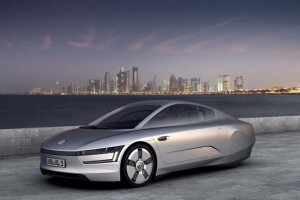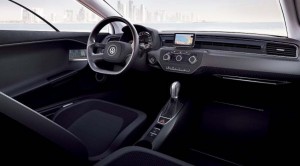You could dole fuel out with an eyedropper and ignore the latest pump prices were the Volkswagen XL1 sitting in your driveway. The newest VW concept vehicle claims a fuel economy of a seemingly impossible 250 miles per gallon.
Unveiled at this week’s Qatar Motor Show, the prototype uses a variety of techniques to reduce weight and minimize wind resistance, while turning to a plug-in diesel-hybrid powertrain to squeeze out every last bit of energy.
Among the various steps taken to improve aerodynamics are a closed front end, extensive underbody covers, closed wheels and pin-sized cameras that replace conventional sideview mirrors. The VW XL1 yields a drag coefficient of just 0.19, compared to 0.25 for the relatively slick Toyota Prius.
There’s less than 400 pounds of steel or iron on the XL1. The chassis is a monocoque made of Carbon Fiber Reinforced Plastic, or CFRP, a material normally found on extremely low-volume supercars, such as the Lamborghini Sesto. That and other lightweight materials, such as aluminum and magnesium, and the ceramics of the prototypes brakes, and VW has been able to hold the mass of the XL1 down to just 1,749 pounds.
About the size of the maker’s European small car, the Polo, the XL1 concept measures barely 13 feet, bumper-to-bumper, and just five feet wide. Significantly, it allows the passengers to sit side-by-side, rather than the tandem arrangement of an earlier VW high-mileage concept, the 2009 L1, that nudged the 200 mpg mark.
Notably, while it has a subcompact sedan’s overall footprint, the XL1 adopts a sports car height, about 3.5 feet, or more like a Lamborghini Gallardo, to further cheat the wind.
The Volkswagen XL1’s plug-in hybrid driveline combines a motorcycle-sized 800 cc TDI engine, which makes 47 horsepower, with a 27 hp electric motor. The package directs all 74 ponies to the rear wheels through 7-speed DSG transmission. In battery mode, the XL1’s lithium-ion pack will deliver 22 miles.
While the numbers might not suggest much performance, the XL1 can hit 60 in under 12 seconds – about 2.4 seconds faster than the earlier L1 – and top out at 99 mph.
At 250 mpg, the typical American would need just 60 gallons of diesel a year to drive the typical 15,000 miles — even less if the VW XL1 were driven on electric along during the day’s commute.
While there are no plans to put XL1 into production, VW is nonetheless intent on utilizing some of its weight and fuel-saving breakthroughs. The maker claims it has come up with ways to sharply reduce the cost of producing CFRP, which could help the material migrate from the supercar segment into more mainstream markets.


